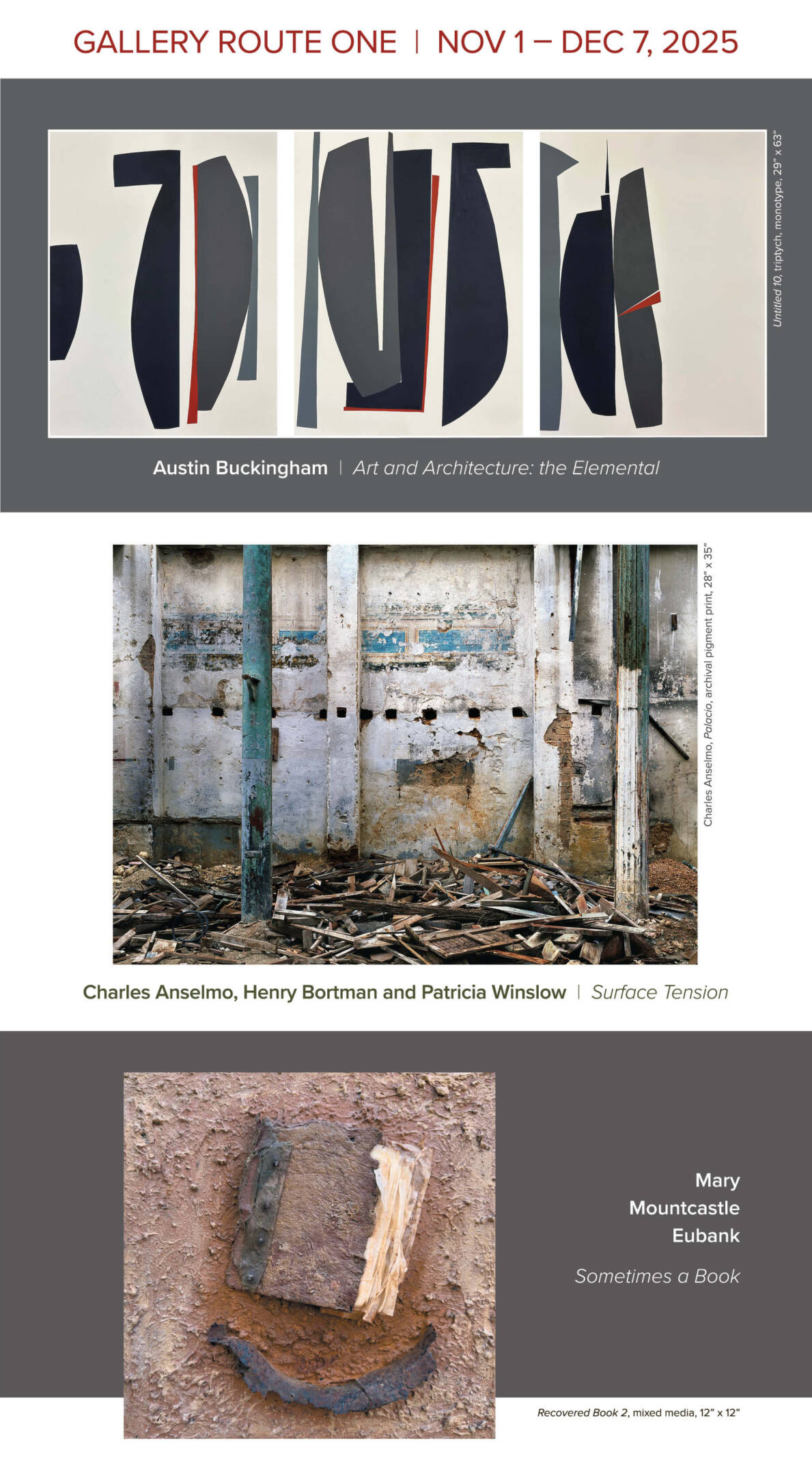
 PO Box 937 / 11101 Highway One / Point Reyes Station, CA 94956 / PH: 415.663.1347 / www.galleryrouteone.org
PO Box 937 / 11101 Highway One / Point Reyes Station, CA 94956 / PH: 415.663.1347 / www.galleryrouteone.orgPress Release: For Immediate Release November 1, 2025
Contact: Patti Trimble pmtrim@gmail.com (707) 360-8189
Upcoming Exhibits at Gallery Route One
November 1 through December 7, 2025
Download PDF
Art and Architecture: the Elemental by AUSTIN BUCKINGHAM
Surface Tension by CHARLES ANSELMO, HENRY BORTMAN & PATRICIA SCOTT WINSLOW
Sometimes a Book by MARY MOUNTCASTLE EUBANK
Gallery Hours 11-5, Thursday through Monday
Opening Reception Saturday, November 1, 3-5pm.
Artist Talks at 3pm
Upcoming Exhibitions at Gallery Route One!
Gallery Route One in Point Reyes Station presents three new exhibitions, November 1 through December 7: Austin Buckingham, inspired by the book ‘Living in a Modern Way, California Design 1930-1965, explores design in art. Large scale polytych and individual works interrogate color, line and form to present a mid-century modern aesthetic. An exhibition of photographs by Charles Anselmo, Henry Bortman and Patricia Scott Winslow, Surface Tension explores the myriad textures, histories and dissonances of the abstracted surfaces which inhabit peripheral urban spaces. Mary Mountcastle Eubank’s exhibition includes sculptural works and paintings about books, each displaying her signature style of layering that suggests weathered surfaces speaking of time.
The public is cordially invited to meet the artists and enjoy a glass of wine at the Opening on Saturday, November 1, from 3 to 5, with artists talks at 3pm. More at https://galleryrouteone.org
AUSTIN BUCKINGHAM: Art and Architecture: the Elemental
Several years ago, I recognized that my knowledge of World War I, World War II, Korean War and Vietnam War was scant. These wars informed the life experience of my great-grandparents (the Lost Generation), grandparents (the Greatest Generation), parents (the Silent Generation), and my generation (the Baby Boomers). I read the histories from various perspectives, the personal stories, the politics of war, the military machinery, and the global trauma that was unleashed. It is estimated that 130 million people died, in total, during these 20th century wars and the interwar years between WWI and WW II. The wars coincided with the industrial age, mechanization, urbanization, the creation of the United Nations and the growing military industrial complex.
During and following these wars, there was a profound cultural shift revealed in visual art, literature, music, fashion and architecture. These events ushered in mass communication, mass production, film, cultural exchange and women entering the labor force; all of which was heavily influenced by the rapid social, political, and technological changes of the era. Modernism was a broad cultural, artistic, and intellectual movement that was characterized by a self-conscious break from traditional forms and a focus on innovation and experimentation. Modernism adopted new fragmented perspectives and a ‘truth to materials’ which often present as abstract art. Modernism was the umbrella name for a number of smaller art movements: Constructivism, Bauhaus, De Stijl, Neoplasticism, Concretism and Brutalism. The through line in these art movements that I found of particular interest and that ultimately inspired the exhibition, is the intersection of art and architecture. Many artists of the Modernist era were also architects, dabbled in architecture, or were inspired by architecture.
This exhibition titled ‘Art and Architecture: the Elemental’ represents my exploration of this theme through the lens of the artistic movements that comprise the Modernism art movement. Of specific focus is Brutalist Architecture which emerged at a time of urgent need for large-scale, affordable residential architecture. Post World War II, Europe’s major cities were heavily bomb- damaged. The need to clear urban slums and a desire to improve the lot of the common citizen, inspired large-scale rehousing projects across much of the continent. With the scale of its designs and emphasis on cheap building materials, Brutalism became the style of choice for many of these projects and public buildings. Brutalism’s most famous stylistic motif was the use of raw concrete (French “béton brut”) for exterior surfaces, leaving evidence of the construction process, such as the holes and seam lines left by the setting of liquid concrete, visible on the outside of buildings. For Brutalist architects this approach rejected ornamentation, with an emphasis on structural honesty, a truth to the textural qualities of materials, and to the labor of construction that epitomized their socially engaged, ethics-driven approach to their work. Brutalism emphasized the physical properties and brash abundance of its building materials, drawing attention to the weight, density, and mass of concrete, steel, and stone.
Instagram: Austin.Buckingham.Studio
More @ GRO
CHARLES ANSELMO, HENRY BORTMAN & PATRICIA SCOTT WINSLOW: Surface Tension
An exhibition of photographs by Charles Anselmo, Henry Bortman and Patricia Scott Winslow, Surface Tension explores the myriad textures, histories and dissonances of the abstracted surfaces which inhabit peripheral urban spaces.
To create representations of a textural, sensate world, how are photographic processes to engage the surface in ways that are congruent with the practice of painters, printmakers and other two-dimensional analog artists? Robert Motherwell addresses the essential tension between the artist and the created surface: “The tactile thing we know by touch. Before this moment, however, it is only a notion enfolded in physicality, then brought to life as space discovers form, color delineates shape and most essentially, line activates surface.”
Through the dialog between idea and practice, between perception and abstraction, photography has been privileged to flatten dimension and compress space as it interprets our quotidian world through a unique visual mimesis. Surface Tension offers photographic representations surrounded by their own immediate context, as floor-to-ceiling images become printed walls to create a tangible plane for framed images that are mounted not in the vacant white expanse of conventional walls, but upon their own congruent surfaces within empirical space.
Engaging ongoing themes related to urban context and the role of memory, Charles Anselmo evaluates the dissonances of the forgotten urban landscape through large scale social-documentary photographs, captured in the warm palette of decay.
Henry Bortman’s quiet, minimalist work explores the subtle shapes and shadings of the natural world. His photographs distill down these immersive multi-sensory experiences and express them as two-dimensional images, often focusing on small details of a scene, rendering them as scale-ambiguous abstractions.
Patricia Scott Winslow explores the narratives of the abstract; walls become canvases denoting not only the social ideas that speak to the current identity of the city, but also become living chronicles of the past.
MARY MOUNTCASTLE EUBANK: Sometimes a Book
My work as an artist has been largely concerned with the interface between Nature and Culture, which has long been an interest of mine. As a lover of books they often figure in the work as representatives of culture alongside nature images. This interface has become more and more in our contemporary world a critical subject to contemplate.
Mary Mountcastle Eubank is one of the original co-founders of Gallery Route One, starting the organization with Toni Littlejohn over forty years ago. She served as Director, then Co-Director of the organization’s Project Space Program for Visiting Artists, before retiring from that role in 2020. Mary lives in a hand-built house at the edge of a forest of pine, oak, bay and madrone trees covering the Inverness Ridge, where much of the land belongs to the National Seashore. Her paintings, assemblages and artist’s books owe much of their meditative atmosphere to the forest and the solitude she experiences living among the trees. The gallery is fortunate to have Mary’s creative presence and artwork on exhibition. To see more of her work, check out her large evocative painting titled TREE, LADDER, BOOK, which graces the main wall of The Station House Cafe Restaurant in downtown Point Reyes Station.
Gallery Route One is a nonprofit art organization. Our mission is to originate and present contemporary art exhibitions, educational programs, and community outreach, to inspire people to experience the world in new ways. The gallery was founded by 25 artists in 1983 and currently maintains a membership of 17 artists and 2 Fellows. Our Board of Directors is drawn from interested community members, including artists. The organization offers two exhibition programs: Artist Member exhibitions, and Guest Artist Program exhibitions that feature guest artists.
